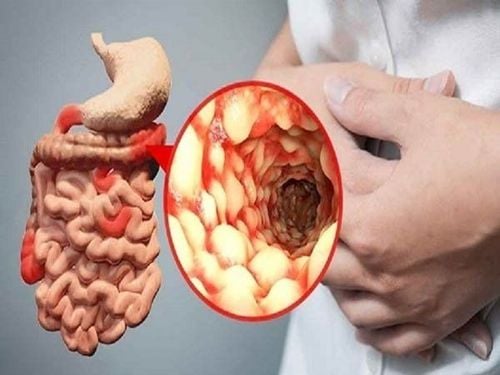This is an automatically translated article.
The article was professionally consulted by Specialist Doctor II Le Thanh Cam - Department of Pediatrics - Neonatology, Vinmec Da Nang International General Hospital. He has 15 years of experience in diagnosing & treating pediatric diseases, having worked at Da Nang Hospital and Danang Center for Obstetrics and Gynecology. Her strength is diagnosis and treatment of pediatric pathology, resuscitation, pediatric emergency.Laryngeal softening causes wheezing sounds in infants, and is also the most common congenital anomaly of the larynx. 99% of children will gradually heal on their own without treatment.
1. Laryngeal flaccid disease in young children
Laryngeal softening is considered a congenital abnormality that causes the epiglottis to narrow during inspiration, leading to intermittent upper airway obstruction and laryngeal stridor.2. How to overcome soft laryngeal cartilage
2.1. Diagnosis Diagnosing a child with laryngospasm by endoscopy with a flexible tube will show that the epiglottis is bulging, and puts pressure on the vestibular region of the larynx with each inhalation. The soft cartilage cap is elongated, folded, and looks like an omega Ω symbol. Every time the child inhales air, the cartilage cover covers or presses on the glottis, causing the glottis to narrow, causing obstruction, the child has difficulty breathing and a hissing sound appears. In fact, that hiss is caused by the cause of the thyroid gland becoming abnormally large, or because of cardiovascular disease, congenital lung disease..., people often measure pH to assess the level of reflux of the stomach. duodenum.
Then, the doctor will order X-rays when needed to identify problems that may accompany the disease. X-rays of the neck and chest area will help the doctor see the difficult airway structure under the epiglottis. And more than that, the doctor will conduct a fluoroscopy airway to see other organ structures of the neck and chest area each time the child breathes.
2.2. Treatment 2.2.1. Basic Treatment Medical Treatment Over 99% will gradually resolve without treatment, most will stop wheezing by 2 years of age. Wheezing will increase during the first 6 months after birth because the amount of air the baby breathes increases with age. After that age, the wheezing does not increase anymore and gradually decreases and then disappears. In many cases, the symptoms disappear, but the pathologic features persist into adulthood and the child may return wheezing with exertion or occasionally with respiratory viral infections.
This disease has no specific medicine to treat, only vitamin D and calcium supplements can be enhanced. Usually treated in the presence of gastroesophageal reflux and associated respiratory infections.
If the baby is still able to suckle, play, gain weight normally, only have wheezing in the first 2 months after birth, no further treatment is needed. Laryngitis is a common diagnosis and the doctor will reassure the child's parents about the nature of this condition.
When does the child need to be hospitalized?
In most cases, hospitalization is not necessary unless the child shows signs of hypoxia or stops breathing. In case blood oxygen saturation is higher than 90%, oxygen is not required. When children experience severe hypoxia, they need to be hospitalized to have their blood oxygen levels measured. If the resting blood oxygen level is <90%, the child will be given oxygen.
Outpatient treatment
No need to give the child any other medicine.
Re-examination as prescribed by the doctor if any
Still vaccinated as normal for the child.
Surgical treatment For severe cases that cause babies to have difficulty breastfeeding, poor weight gain and development, surgery can be used.
The surgery simply involves shaping the supporting structures around the epiglottis, removing excess tissue that obstructs the airways.
Very rarely, surgery is required to treat softening of the laryngeal cartilage. If the child has had surgery, it is still advisable to continue to treat gastroesophageal reflux disease and parents still need to watch for signs of bad changes to promptly take the child to a medical facility.
Methods of soft surgery of laryngeal cartilage for young children: laryngoscopy at the larynx, bronchoscopy, microsurgery of upper larynx.
Is laryngeal soft tissue surgery dangerous?
Complications of epiglottitis and tracheostomy are quite possible. The risk of complications and sequelae of tracheostomy has a mortality rate of 2%. However, surgery is still required in case the child is seriously ill and prescribed by a doctor.

Mild level Follow up:
Clinically there is laryngopharyngeal stridor, and through Endoscopy showed the features of laryngeal soft cartilage. There was no respiratory distress and no evidence of growth retardation in the infant. These cases can be monitored and do not require surgical intervention. You can be reassured about the possibility of the disease regressing on its own. Periodic re-examination and growth monitoring until disease remission.
Supportive treatment:
Treatment of gastroesophageal reflux - oesophagitis when necessary. Laryngeal softening and gastroesophageal reflux disease are two often related conditions, and one can aggravate the other. If in doubt, evaluate and treat reflux. Reflux control can help improve airway obstruction by reducing edema and inflammation of the lining of the larynx.
Measures:
Should give the patient solid food, eat in an upright position, combine with some drugs to reduce gastric acid secretion, drugs to support the treatment of gastric reflux.
Moderate Option 1: Follow-up
Clinically, the child has laryngeal squeak, accessory respiratory muscle contractions, difficulty breastfeeding, and weight loss or inadequate weight gain. Reflux symptoms and dysphagia should be evaluated for appropriate treatment.
Should the baby's condition be closely monitored to find out if the disease is getting worse?, is the airway more blocked or feeding is more difficult?, the weight is consistent with the growth chart for the age or not. are not?.
Supportive treatment:
Treatment of gastroesophageal reflux - oesophagitis when necessary.
Option 2: Surgery
Indications:
When the child has severe airway obstruction and respiratory failure, or when the child cannot suckle enough for normal growth.
The most commonly used surgery is the glottis-fungal cartilage reconstruction method to reshape the epiglottis and release the blockage.
Supportive treatment:
Tracheostomy when necessary. However, it is important to note the risks of complications and sequelae of tracheostomy, which have a mortality rate of 2%. Treat gastroesophageal reflux when necessary. Option 3: Two-stroke positive pressure ventilation - BiPAP
Indications:
Cases where breathing can stop during sleep, or surgery but does not help improve the condition or in children with contraindications to surgery.
BiPAP can also be used as a procrastination measure. For example, BiPAP can help prolong the time between surgeries.
Supportive treatment :
Treatment of gastroesophageal reflux - oesophagitis when necessary.
Severity Option 1: Surgery
Indications:
Severe disease occurs in 10%-15% of cases. Funnel-laryngeal splint shaping to relieve epiglottitis is a commonly used measure.
Supportive treatment:
Tracheostomy when necessary. However, it is important to note the risks of complications and sequelae of tracheostomy, which have a mortality rate of 2%. Treat gastroesophageal reflux when necessary. Option 2: Two-stroke positive pressure ventilation - BiPAP
Indications:
Cases where breathing can stop while sleeping, or surgery but does not help improve the condition or in children with contraindications to surgery.
Supportive treatment:
Treatment of gastroesophageal reflux - oesophagitis when necessary.
3. What to do when the child has soft laryngeal cartilage?

When taking care of children, parents should note:
Limiting children lying on their backs Under the effect of gravity, the more laryngeal cartilage tissue protrudes into the child's airway, the more wheezing the child becomes. For newborns, you should let the child lie on his side, sometimes turning over to help him feel less tired, and for older children, he will lie down in the position that he feels most comfortable to breathe.
Breastfeeding properly Some babies with soft larynx will find it difficult to suckle. Therefore, mothers need to be alert when breastfeeding to adjust the amount of milk to suit the baby's sucking capacity, avoiding the very dangerous phenomenon of choking.
Cleaning the nose and throat before going to sleep Before going to bed, remember to clean the baby's nose with physiological saline solution so that the baby's nose is open, helping the baby breathe easier. Children with soft laryngeal cartilage or breathing through the mouth when sleeping, you should apply lip balm to your baby to avoid dry, chapped lips, and breastfeeding will be very difficult.
Enhance resistance Minimize respiratory diseases because children with soft laryngeal cartilage wheeze more when suffering from these diseases. When children enter the age of weaning, parents should add foods rich in vitamin C to help strengthen their resistance and prevent common respiratory infections.
Periodic examination Check and monitor the health status of children periodically. If the child has soft laryngeal cartilage leading to weight loss, apnea, aborting, ..., the child must be taken to a medical center for timely support. Parents should periodically send children to the hospital to measure the saturation of fresh oxygen in the blood.
Lifestyle There is no need to abstain from any food nor restrict any physical activity of the child. Give your child regular vaccinations to prevent other diseases.
As a key area of Vinmec Health system, Pediatrics Department always brings satisfaction to customers and is highly appreciated by industry experts with:
Gathering a team of top doctors and nurses in Pediatrics : consists of leading experts with high professional qualifications (professors, associate professors, doctorates, masters), experienced, worked at major hospitals such as Bach Mai, 108.. Doctors All doctors are well-trained, professional, conscientious, knowledgeable about young psychology. In addition to domestic pediatric specialists, the Department of Pediatrics also has the participation of foreign experts (Japan, Singapore, Australia, USA) who are always pioneers in applying the latest and most effective treatment regimens. . Comprehensive services: In the field of Pediatrics, Vinmec provides a series of continuous medical examination and treatment services from Newborn to Pediatric and Vaccine,... according to international standards to help parents take care of their baby's health from birth to childhood. from birth to adulthood Specialized techniques: Vinmec has successfully deployed many specialized techniques to make the treatment of difficult diseases in Pediatrics more effective: neurosurgery - skull surgery, stem cell transplantation. blood in cancer treatment. Professional care: In addition to understanding children's psychology, Vinmec also pays special attention to the children's play space, helping them to have fun and get used to the hospital's environment, cooperate in treatment, improve the efficiency of medical treatment.
Please dial HOTLINE for more information or register for an appointment HERE. Download MyVinmec app to make appointments faster and to manage your bookings easily.














